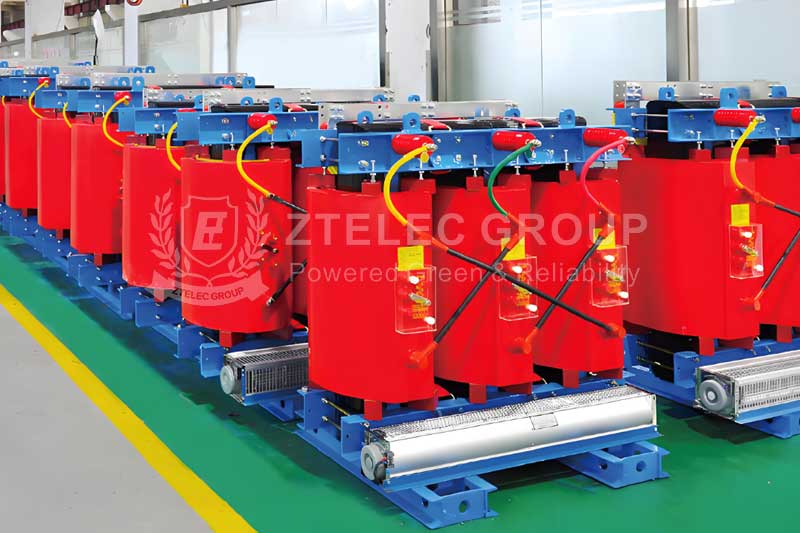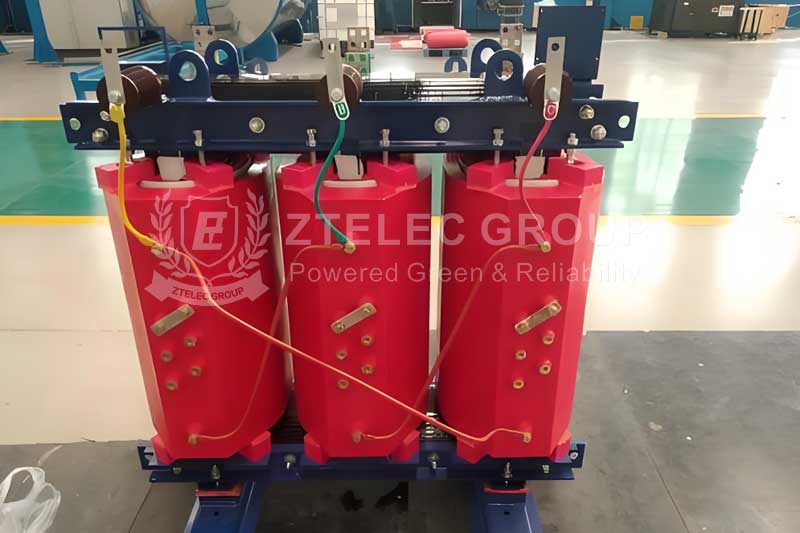The Different Parts of a Dry Type Transformer
The Different Parts of a Dry Type Transformer
A dry-type transformer is a device widely used in power systems due to its significant performance advantages and environmental adaptability. In modern power engineering, dry-type transformers are particularly suitable for urban distribution networks, high-rise buildings, industrial facilities, and areas with strict environmental requirements. Understanding the structure of dry-type transformers and the functions of their various components is crucial for the effective use and maintenance of this equipment. This article will provide a detailed analysis of the main components of dry-type transformers.

Dry Type Transformer Core
The core of a transformer is a vital component of dry-type transformers, primarily serving to provide a low magnetic reluctance path for effective magnetic flux conduction. The cores of dry-type transformers are typically made of high-quality silicon steel sheets, which are assembled in laminated form to reduce eddy current losses. The design of the core directly impacts the efficiency and load capacity of the transformer; an appropriately designed air gap can enhance its magnetic flux saturation, allowing it to operate stably under varying load conditions.
Insulation treatment of the core is also critical. Devices like dry-type transformers often require protection against short circuit faults and current leakage. Therefore, good insulation materials must be placed between each layer of the core material. These insulation materials effectively prevent current from flowing on the surface of the core, thereby minimizing energy loss and ensuring the safe and normal operation of the transformer.
Transformer Windings
The windings are the core part of a dry-type transformer, responsible for converting voltage and current, and transferring electrical energy from the primary side (input side) to the secondary side (output side) through inductive coupling. The windings of dry-type transformers are usually made of high-quality copper or aluminum wire, which offers excellent electrical and thermal conductivity. The turns ratio of the windings affects the output voltage, making the design of the windings crucial for meeting different application requirements.
The windings are typically divided into high-voltage and low-voltage windings, which are well insulated from each other using air or insulating materials to prevent safety hazards such as short circuits or electric shocks. Each winding also requires sufficient insulation layers to ensure that it does not suffer from insulation aging or damage due to heat buildup during long-term operation. Proper ventilation and cooling designs are also important considerations in winding design to ensure effective heat dissipation under high-load conditions, reducing the risk of overheating.

Transformer Insulation Materials
Insulation materials are essential components of dry-type transformers, ensuring the electrical safety and performance stability of the entire device. To enhance the durability and reliability of the transformer, dry-type transformers generally utilize multilayer insulation technology, which reduces the risk of breakdown voltage by adding insulation layers between the windings and the core.
The types of insulation materials used in dry-type transformers are diverse, including epoxy resin, polyester fiber, and other high-performance insulation materials. These materials can withstand high voltage and high temperatures while also offering good weather resistance and aging resistance. Most modern dry-type transformers' insulation materials comply with standards from international organizations, ensuring that the transformers used are reliable under various environmental conditions.
Transformer Cooling System
The cooling system is an important aspect of dry-type transformers that cannot be overlooked during operation. Since transformers generate heat in working states, efficient heat dissipation is crucial for reducing the risk of equipment failures. Most dry-type transformers rely on a combination of natural and forced convection cooling to manage temperature. Particularly under high-load conditions, the design and efficiency of the cooling system directly affect the operational performance and lifespan of the transformer.
The cooling system typically includes components such as radiators and fans. Radiators increase the surface area to accelerate heat dissipation while fans enhance the airflow rate, further improving cooling efficiency. A well-designed cooling system can prevent unexpected shutdowns or equipment damage due to overheating while ensuring the efficient operation of the transformer.
Shell and Support
The shell and support make up the structural components of dry-type transformers, providing protection for internal components and mechanical support. The shell of dry-type transformers is usually made of aluminum or steel, offering good corrosion resistance and protective performance. Its design must consider both protection and securing functionality while adapting to various environmental usage needs.
In extreme situations such as earthquake and shock resistance, the structural design of the shell must be sufficiently robust to ensure that the transformer can operate safely and stably in harsh environments. Additionally, the shell is equipped with ventilation channels to effectively promote internal airflow and maintain stable internal temperatures.
As an indispensable part of power systems, the design and function of each component within dry-type transformers play a critical role in the overall performance of the equipment. Understanding the main components of dry-type transformers helps optimize their use, prevent potential failures, and provide significant assurance for the efficient and stable operation of modern power systems. With advancements in technology, dry-type transformers will continue to innovate in design materials, structural forms, and cooling mechanisms to meet the increasingly stringent electrical demands and environmental protection requirements of the future.
- more+releated article
- 2026-01-04Common Power Transformer Faults: Causes, Solut
- 2025-12-312026 New Year Holiday Notice
- 2025-12-31Operation, Maintenance, and Service Life Manag
- 2025-12-30How to Select a 100 kVA–500 kVA Distribution
- 2025-12-29The Impact of NHN NMN Composite Insulation on
- 2025-12-26Practical Application of GPO-3 Insulation Boar
- 2025-12-2510kV Transformer Replacement Timeline: Install
- 2025-12-25Low Smoke EN45545 GPO3 UPGM203 Laminated Board
- 2025-12-24Merry Christmas — ZTelecgroup Christmas Cele
- 2025-12-24How to Select a Suitable 50kVA–500kVA Distri





